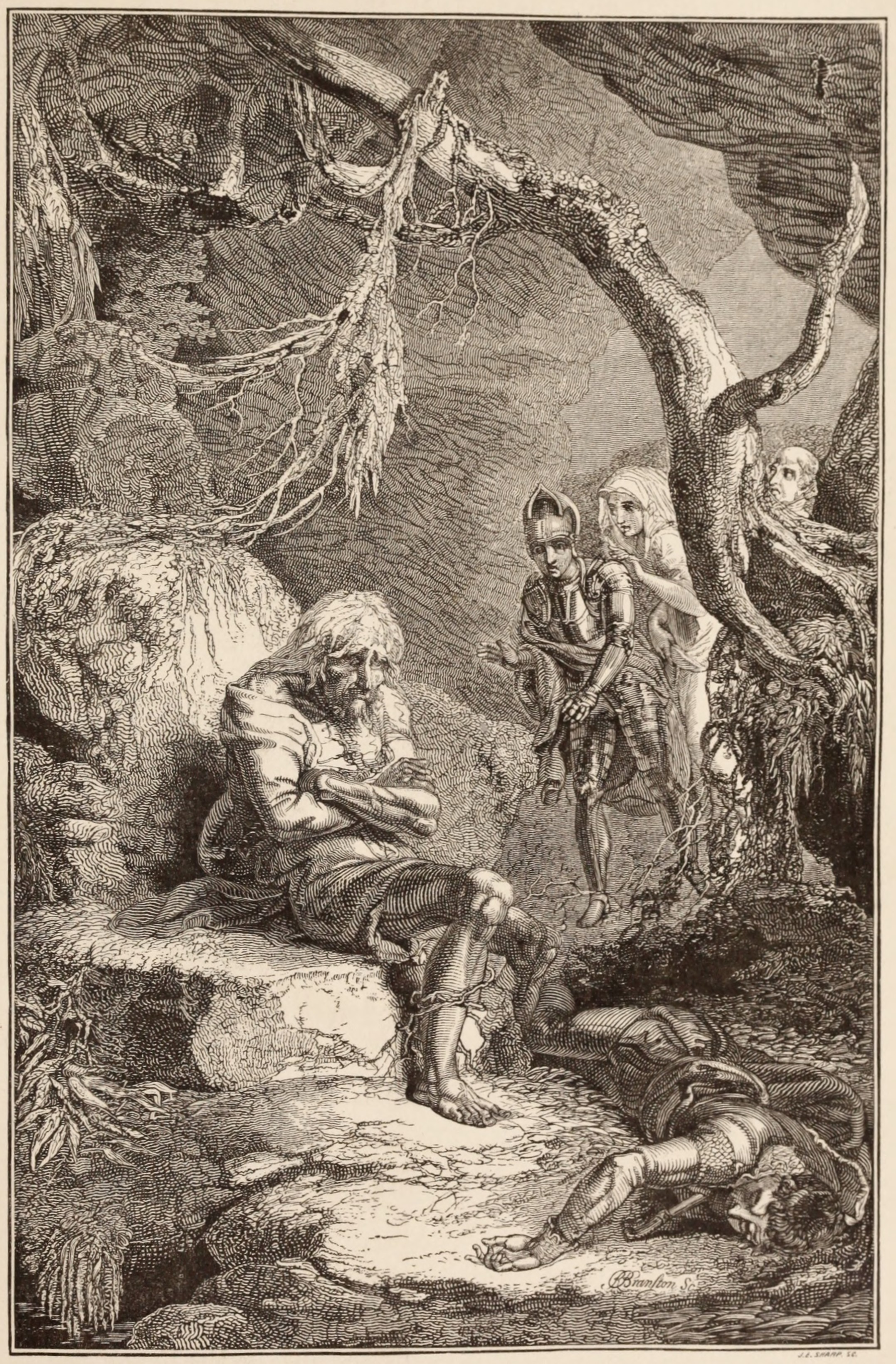Allen Robert Branston on:
[Wikipedia]
[Google]
[Amazon]
Allen Robert Branston (1778–1827) known more generally as Robert Branston, was a British

 The 'Cave of Despair,' after Thurston, in
The 'Cave of Despair,' after Thurston, in
wood-engraver
Wood engraving is a printmaking technique, in which an artist works an image into a block of wood. Functionally a variety of woodcut, it uses relief printing, where the artist applies ink to the face of the block and prints using relatively lo ...
.
Life
Branston was the son of a general copper plate engraver and heraldic painter, born atLynn, Norfolk
King's Lynn, known until 1537 as Bishop's Lynn and colloquially as Lynn, is a port and market town in the borough of King's Lynn and West Norfolk in the county of Norfolk, England. It is north-east of Peterborough, north-north-east of Cambridg ...
in 1778. He was apprenticed to his father, and when in his nineteenth year settled at Bath
Bath may refer to:
* Bathing, immersion in a fluid
** Bathtub, a large open container for water, in which a person may wash their body
** Public bathing, a public place where people bathe
* Thermae, ancient Roman public bathing facilities
Plac ...
, where he practised both as a painter and engraver. He came to London
London is the Capital city, capital and List of urban areas in the United Kingdom, largest city of both England and the United Kingdom, with a population of in . London metropolitan area, Its wider metropolitan area is the largest in Wester ...
in 1799, and after a while devoted himself to wood-engraving, in which branch of the art of engraving he was self-taught. Branston died at Brompton in 1827. The engravers Robert Edward Branston and William Frederick Branston were his sons.
Works
He was employed mainly onbook illustration
The illustration of manuscript books was well established in ancient times, and the tradition of the illuminated manuscript thrived in the West until the invention of printing. Other parts of the world had comparable traditions, such as the Per ...
, after the designs of John Thurston and others. He soon became the head of his profession in London, where nothing equal to Thomas Bewick
Thomas Bewick (c. 11 August 1753 – 8 November 1828) was an English wood engraving, wood-engraver and natural history author. Early in his career he took on all kinds of work such as engraving cutlery, making the wood blocks for advertisements, ...
and his pupils had been produced before his arrival. With Bewick he was always in rivalry, yet, though he was no designer and some twenty-three years the junior of the Newcastle
Newcastle usually refers to:
*Newcastle upon Tyne, a city and metropolitan borough in Tyne and Wear, England, United Kingdom
*Newcastle-under-Lyme, a town in Staffordshire, England, United Kingdom
*Newcastle, New South Wales, a metropolitan area ...
master, he may claim to be the founder of the 'London school' of wood-engraving, and to some extent to share with Bewick the credit of raising the character of his art in England
England is a Countries of the United Kingdom, country that is part of the United Kingdom. It is located on the island of Great Britain, of which it covers about 62%, and List of islands of England, more than 100 smaller adjacent islands. It ...
. He specially excelled in engraving figures and interiors, but was less successful in outdoor scenes.

 The 'Cave of Despair,' after Thurston, in
The 'Cave of Despair,' after Thurston, in William Savage
William Savage (1720 – 27 July 1789) was an English composer, organist, and singer of the 18th century. He sang as a boy treble and alto, a countertenor, and as a bass. He is best remembered for his association with the composer George Frid ...
's ''Practical Hints on Decorative Printing'', 1822, is generally considered his best plate, and shows his skill both in 'white' and 'black' line. Amongst the works illustrated in whole or in part by him were edition of David Hume
David Hume (; born David Home; – 25 August 1776) was a Scottish philosopher, historian, economist, and essayist who was best known for his highly influential system of empiricism, philosophical scepticism and metaphysical naturalism. Beg ...
's ''The History of England'' published by Wallis and Scholey, 1804–10; Robert Bloomfield
Robert Bloomfield (3 December 1766 – 19 August 1823) was an English labouring-class poet, whose work is appreciated in the context of other self-educated writers, such as Stephen Duck, Mary Collier and John Clare.
Life
Robert Bloomfield ...
's ''Wild Flowers'', 1806; and poems by George Marshall
George Catlett Marshall Jr. (31 December 1880 – 16 October 1959) was an American army officer and statesman. He rose through the United States Army to become Chief of Staff of the United States Army, Chief of Staff of the U.S. Army under pres ...
, 1812. He had many pupils, including John Thompson (1785–1866). The work of Branston and Thompson can be compared in the illustrations to James Puckle
James Puckle (1667–1724) was an English inventor, lawyer and writer from London chiefly remembered for his invention of the ''Defence Gun'', better known as the ''Puckle gun'', a multi-shot gun mounted on a stand capable of (depending on whic ...
's ''The Club'', 1817. Branston projected a volume of fables in rivalry with those of Bewick after designs by Thurston, but after a few of them were cut he abandoned the enterprise. He also engraved a few cuts of bird
Birds are a group of warm-blooded vertebrates constituting the class (biology), class Aves (), characterised by feathers, toothless beaked jaws, the Oviparity, laying of Eggshell, hard-shelled eggs, a high Metabolism, metabolic rate, a fou ...
s to show his superiority to the Newcastle engraver; but though beautifully cut, they were essentially inferior to Bewick's.
References
{{DEFAULTSORT:Branston, Allen Robert 1778 births 1827 deaths British wood engravers People from King's Lynn 18th-century English male artists 19th-century English male artists